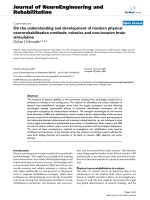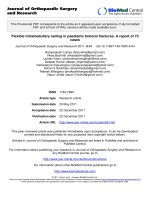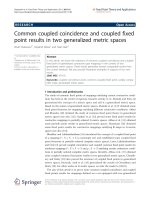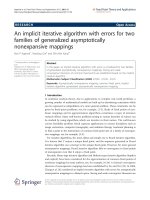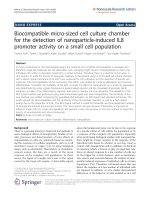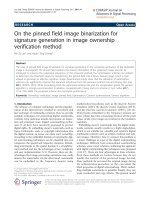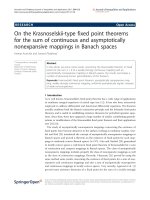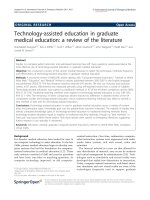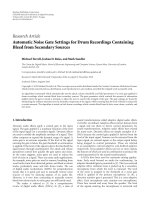Báo cáo hóa học: "ON RANDOM COINCIDENCE AND FIXED POINTS FOR A PAIR OF MULTIVALUED AND SINGLE-VALUED MAPPINGS" pot
Bạn đang xem bản rút gọn của tài liệu. Xem và tải ngay bản đầy đủ của tài liệu tại đây (520.8 KB, 12 trang )
ON RANDOM COINCIDENCE AND FIXED POINTS FOR
A PAIR OF MULTIVALUED AND SINGLE-VALUED MAPPINGS
LJUBOMIR B.
´
CIRI
´
C, JEONG S. UME, AND SINI
ˇ
SA N. JE
ˇ
SI
´
C
Received 2 February 2006; Revised 21 June 2006; Accepted 22 July 2006
Let (X,d) be a Polish space, CB(X) the family of all nonempty closed and bounded
subsets of X,and(Ω,Σ) a measurable space. A pair of a hybrid measurable m appings
f : Ω
× X → X and T : Ω × X → CB(X), satisfying the inequality (1.2), are introduced
and investigated. It is proved that if X is complete, T(ω,
·), f (ω,·) are continuous for all
ω
∈ Ω, T(·,x), f (·,x) are measurable for all x ∈ X,and f (ω × X) = X for each ω ∈ Ω,
then there is a measurable mapping ξ : Ω
→ X such that f (ω, ξ(w)) ∈ T(ω,ξ(w)) for
all ω
∈ Ω. This result generalizes and extends the fixed point theorem of Papageorgiou
(1984) and many classical fixed point theorems.
Copyright © 2006 Ljubomir B.
´
Ciri
´
c et al. This is an open access article dist ributed under
the Creative Commons Attribution License, which permits unrestricted use, distribution,
and reproduction in any medium, provided the original work is properly cited.
1. Introduction and preliminaries
Random fixed point theorems are stochastic generalizations of classical fixed point the-
orems. Random fixed point theorems for contraction mappings on separable complete
metric spaces have been proved by several authors (Zhang and Huang [25], Han
ˇ
s[6, 7],
Itoh [8], Lin [12], Papageorgiou [13, 14], Shahzad and Hussian [19, 20],
ˇ
Spa
ˇ
cek [22],
and Tan and Yuan [23]). The stochastic version of the well known Schauder’s fixed point
theorem was proved by Sehgal and Singh [18].
Let (X,d) be a metric space and T : X
→ X a mapping. The class of mappings T satis-
fying the following contractive condition:
d(Tx,Ty)
≤ αmax
d(x, y),d(x,Tx),d(y,Ty),
d(x,Ty)+d(y,Tx)
2
+ βmax
d(x,Tx),d(y,Ty)
+ γ
d(x,Ty)+d(y,Tx)
(1.1)
for all x, y
∈ X,whereα, β, γ are nonnegative real numbers such that β>0, γ>0, and α +
β +2γ
= 1, was introduced and investigated by
´
Ciri
´
c[1].
´
Ciri
´
c proved that in a complete
Hindawi Publishing Corporation
Journal of Inequalities and Applications
Volume 2006, Article ID 81045, Pages 1–12
DOI 10.1155/JIA/2006/81045
2 On random coincidence and fixed points
metric space such mappings have a unique fixed point. This class of mappings was further
studied by many authors (
´
Ciri
´
c[2, 3], Singh and Mishra [21], and Rhoades et al. [16]).
Singh and Mishra [21] have generalized
´
Ciri
´
c’s [2] fixed point theorem to a common fixed
point theorem of a pair of mappings and presented some application of such theorems to
dynamic programming.
Let (Ω,Σ) be a measurable space with Σ a sigma algebra of subsets of Ω and let (X,d)
beametricspace.Wedenoteby2
X
the family of all subsets of X,byCB(X) the family
of all nonempty closed and bounded subsets of X,andbyH the Hausdorff metric on
CB(X), induced by the metric d.Foranyx
∈ X and A ⊆ X,byd(x,A) we denote the
distance between x and A, that is, d(x,A)
= inf{d(x,a):a ∈ A}.
AmappingT : Ω
→ 2
X
is cal led Σ-measurable if for any open subset U of X, T
−1
(U) =
{
ω : T(w) ∩ U =∅}∈Σ. In what follows, when we speak of measurability we wil l mean
Σ-measurability. A mapping f : Ω
× X → X is called a random operator if for any x ∈ X,
f (
·,x) is measurable. A mapping T : Ω ×X → CB(X)iscalledamultivalued random oper-
ator if for every x
∈ X, T(·,x) is measurable. A mapping s : Ω → X is called a measurable
selector of a measurable multifunction T : Ω
→ 2
X
if s is measurable and s(ω) ∈ T(ω)
for all ω
∈ Ω. A measurable mapping ξ : Ω → X is called a random fixed point ofaran-
dom multifunction T : Ω
× X → CB(X)ifξ(w) ∈ T(w,ξ(w)) for every w ∈ Ω.Amea-
surable mapping ξ : Ω
→ X is called a random coincidence of T : Ω × X → CB(X)and
f : Ω
× X → X if f (ω,ξ(w)) ∈ T(w,ξ(w)) for every w ∈ Ω.
The aim of this paper is to prove a stochastic analog of the
´
Ciri
´
c[1] fixed point theo-
rem for single-valued mappings, extended to a coincidence theorem for a pair of a ran-
dom operator f : Ω
× X → X and a multivalued random operator T : Ω × X → CB(X),
satisfying the following nonexpansive-type condition: for each ω
∈ Ω,
H
T(ω,x),T(ω, y)
≤
α(ω)max
d
f (ω, x), f (ω, y)
,d
f (ω, x),T(ω, x)
,d
f (ω, y),T(ω, y)
,
1
2
d
f (ω, x),T(ω, y)
+ d
f (ω, y),T(ω,x)
+ β(ω)max
d
f (ω, x),T(ω, x)
,d
f (ω, y),T(ω, y)
+ γ(ω)
d
f (ω, x),T(ω, y)
+ d
f (ω, y),T(ω,x)
(1.2)
for every x, y
∈ X,whereα,β,γ : Ω → [0, 1) are measurable mapping s such that for all
ω
∈ Ω,
β(ω) > 0, γ(ω) > 0, (1.3)
α(ω)+β(ω)+2γ(ω)
= 1. (1.4)
2. Main results
Now we are proving our main result.
Ljubomir B.
´
Ciri
´
cetal. 3
Theorem 2.1. Let (X,d) be a complete separable metric space, let (Ω,Σ) be a measurable
space, and let T : Ω
× X → CB(X) and f : Ω ×X → X be mappings such that
(i) T(ω,
·), f (ω,·) are continuous for all ω ∈ Ω,
(ii) T(
·,x), f (·,x) are measurable for all x ∈ X,
(iii) they satisfy (1.2), where α(ω),β(ω),γ(ω):Ω
→ X satisfy (1.3)and(1.4).
If f (ω
× X) = X for each ω ∈ Ω, then there is a measurable mapping ξ : Ω → X such that
f (ω, ξ(w))
∈ T(w, ξ(w)) for all ω ∈ Ω (i.e., T and f have a random coincidence point).
Proof. Let Ψ
={ξ : Ω → X} be a family of measurable mappings. Define a function g :
Ω
× X → R
+
as follows:
g(ω,x)
= d
x, T(ω,x)
. (2.1)
Since x
→ T(ω,x) is continuous for all ω ∈ Ω,weconcludethatg(ω,·)iscontinuousfor
all ω
∈ Ω. Also, since ω → T(ω,x)ismeasurableforallx ∈ X,weconcludethatg(·,x)is
measurable (see Wagner [24, page 868]) for all ω
∈ Ω.Thusg(ω,x)istheCaratheodory
function. Therefore, if ξ : Ω
→ X is a measurable mapping, then ω → g(ω,ξ(w)) is also
measurable (see [17]).
Now we will construct a sequence of measurable mappings
{ξ
n
} in Ψ and a sequence
{ f (ω,ξ
n
(ω))} in X as follows. Let ξ
0
∈ Ψ be arbitrary. Then the multifunction G : Ω →
CB(X)definedbyG(ω) = T(w,ξ
0
(w)) is measurable.
From the Kuratowski and Ryll-Nardzewski [11] selector theorem, there is a measurable
selector μ
1
: Ω → X such that μ
1
(ω) ∈ T(w,ξ
0
(w)) for all ω ∈ Ω.Sinceμ
1
(ω)∈T(w,ξ
0
(w))
⊆ X = f (ω × X), let ξ
1
∈ Ψ be such that f (ω, ξ
1
(ω)) = μ
1
(ω). Thus f (ω,ξ
1
(ω)) ∈ T(ω,
ξ
0
(ω)) for all ω ∈ Ω.
Let k : Ω
→ (1,∞)bedefinedby
k(ω)
= 1+
β(ω)γ(ω)
2
(2.2)
for all ω
∈ Ω.Thenk(ω) is measurable. Since k(ω) > 1and f (ω,ξ
1
(ω)) is a selector of
T(w,ξ
0
(w)), from Papageorgiou [13, Lemma 2.1] there is a measurable selector μ
2
(ω) =
f (ω, ξ
2
(ω)); ξ
2
∈ Ψ, such that for all ω ∈ Ω,
f
ω,ξ
2
(ω)
∈
T
ω,ξ
1
(ω)
,
d
f
ω,ξ
1
(ω)
, f
ω,ξ
2
(ω)
≤
k(ω)H
T
ω,ξ
0
(ω)
,T
ω,ξ
1
(ω)
.
(2.3)
Similarly, as f (ω,ξ
2
(ω)) is a selector of T(w, ξ
1
(w)), there is a measurable selector μ
3
(ω) =
f (ω, ξ
3
(ω)) of T(ω,ξ
2
(ω)) ⊆ f (ω × X)suchthat
d
f
ω,ξ
2
(ω)
, f
ω,ξ
3
(ω)
≤
k(ω)H
T
ω,ξ
1
(ω)
,T
ω,ξ
2
(ω)
. (2.4)
Continuing this process we can construct a sequence of measurable mappings μ
n
: Ω → X,
defined by μ
n
(ω) = f (ω,ξ
n
(ω)); ξ
n
∈ Ψ,suchthat
f
ω,ξ
n+1
(ω)
∈
T
ω,ξ
n
(ω)
, (2.5)
d
f
ω,ξ
n
(ω)
, f
ω,ξ
n+1
(ω)
≤
k(ω)H
T
ω,ξ
n−1
(ω)
,T
ω,ξ
n
(ω)
. (2.6)
4 On random coincidence and fixed points
Observe that condition (1.2) is clumsy. So, for simplicity, in the rest of the paper we will
use this condition in the following form:
H
T(ω,x),T(ω, y)
≤
α(ω)max
d
f (ω, x), f (ω, y)
,·,·,
1
2
[· + ·]
+ β(ω)max
d
f (ω, x),T(ω, x)
,d
f (ω, y),T(ω, y)
+ γ(ω)
d
f (ω, x),T(ω, y)
+ d
f (ω, y),T(ω,x)
.
(2.7)
From (2.7),
H
T
ω,ξ
0
(ω)
,T
ω,ξ
1
(ω)
≤
α(ω)max
d
f
ω,ξ
0
(ω)
, f
ω,ξ
1
(ω)
,·,·,
1
2
[· + ·]
+ β(ω)max
d
f
ω,ξ
0
(ω)
,T
ω,ξ
0
(ω)
,d
f
ω,ξ
1
(ω)
,T
ω,ξ
1
(ω)
+ γ(ω)
d
f
ω,ξ
0
(ω)
,T
ω,ξ
1
(ω)
+ d
f
ω,ξ
1
(ω)
,T
ω,ξ
0
(ω)
.
(2.8)
Since f (ω,ξ
1
(ω)) ∈ T(ω,ξ
0
(ω)), then
d
f
ω,ξ
1
(ω)
,T
ω,ξ
0
(ω)
=
0,
d
f
ω,ξ
0
(ω)
,T
ω,ξ
0
(ω)
≤
d
f
ω,ξ
0
(ω)
, f
ω,ξ
1
(ω)
,
d
f
ω,ξ
1
(ω)
,T
ω,ξ
1
(ω)
≤
H
T
ω,ξ
0
(ω)
,T
ω,ξ
1
(ω)
.
(2.9)
Thus from (2.8),
H
T
ω,ξ
0
(ω)
,T
ω,ξ
1
(ω)
≤
α(ω)max
d
f
ω,ξ
0
(ω)
, f
ω,ξ
1
(ω)
,·,·,
1
2
[· + ·]
+ β(ω)max
d
f
ω,ξ
0
(ω)
, f
ω,ξ
1
(ω)
,H
T
ω,ξ
0
(ω)
,T
ω,ξ
1
(ω)
+ γ(ω)
d
f
ω,ξ
0
(ω)
, f
ω,ξ
1
(ω)
+ H
T
ω,ξ
0
(ω)
,T
ω,ξ
1
(ω)
.
(2.10)
If we assume that H(T(ω,ξ
0
(ω)),T(ω,ξ
1
(ω)))>d( f (ω,ξ
0
(ω)), f (ω,ξ
1
(ω))), then we have,
as γ(ω) > 0,
γ(ω)
d
f
ω,ξ
0
(ω)
, f
ω,ξ
1
(ω)
+ H
T
ω,ξ
0
(ω)
,T
ω,ξ
1
(ω)
< 2γ(ω)H
T
ω,ξ
0
(ω)
,T
ω,ξ
1
(ω)
.
(2.11)
Ljubomir B.
´
Ciri
´
cetal. 5
Thus, from (1.4)and(2.10), we have
H
T
ω,ξ
0
(ω)
,T
ω,ξ
1
(ω)
<α(ω)H
T
ω,ξ
0
(ω)
,T
ω,ξ
1
(ω)
+ β(ω)H
T
ω,ξ
0
(ω)
,T
ω,ξ
1
(ω)
+2γ(ω)H
T
ω,ξ
0
(ω)
,T
ω,ξ
1
(ω)
=
α(ω)+β(ω)+2γ(ω)
H
T
ω,ξ
0
(ω)
,T
ω,ξ
1
(ω)
=
H
T
ω,ξ
0
(ω)
,T
ω,ξ
1
(ω)
,
(2.12)
a contradiction. Therefore,
H
T
ω,ξ
0
(ω)
,T
ω,ξ
1
(ω)
≤
d
f
ω,ξ
0
(ω)
, f
ω,ξ
1
(ω)
. (2.13)
Since d( f (ω,ξ
1
(ω)),T(ω,ξ
1
(ω))) ≤ H(T(ω,ξ
0
(ω)),T(ω,ξ
1
(ω))), we have
d
f
ω,ξ
1
(ω)
,T
ω,ξ
1
(ω)
≤
d
f
ω,ξ
0
(ω)
, f
ω,ξ
1
(ω)
. (2.14)
By induction, we can show that
H
T
ω,ξ
n
(ω)
,T
ω,ξ
n+1
(ω)
≤
d
f
ω,ξ
n
(ω)
, f
ω,ξ
n+1
(ω)
, (2.15)
d
f
ω,ξ
n
(ω)
,T
ω,ξ
n
(ω)
≤
d
f
ω,ξ
n−1
(ω)
, f
ω,ξ
n
(ω)
(2.16)
for each n
≥ 1andallω ∈ Ω.From(2.6)and(2.15),
d
f
ω,ξ
n
(ω)
, f
ω,ξ
n+1
(ω)
≤
k(ω)d
f
ω,ξ
n−1
(ω)
, f
ω,ξ
n
(ω)
. (2.17)
By (2.17), we get
d
f
ω,ξ
0
(ω)
, f
ω,ξ
2
(ω)
≤
d
f
ω,ξ
0
(ω)
, f
ω,ξ
1
(ω)
+ d
f
ω,ξ
1
(ω)
, f
ω,ξ
2
(ω)
≤
1+k(ω)
d
f
ω,ξ
0
(ω)
, f
ω,ξ
1
(ω)
.
(2.18)
From (2.7),
H
T
ω,ξ
0
(ω)
,T
ω,ξ
2
(ω)
≤
α(ω)max
d
f
ω,ξ
0
(ω)
, f
ω,ξ
2
(ω)
,·,·,
1
2
[· + ·]
+ β(ω)max
d
f
ω,ξ
0
(ω)
,T
ω,ξ
0
(ω)
,d
f
ω,ξ
2
(ω)
,T
ω,ξ
2
(ω)
+ γ(ω)
d
f
ω,ξ
0
(ω)
,T
ω,ξ
2
(ω)
+ d
f
ω,ξ
2
(ω)
,T
ω,ξ
0
(ω)
.
(2.19)
6 On random coincidence and fixed points
Using (2.15), (2.16), (2.17), and (2.18) and the triangle inequality, we get
d
f
ω,ξ
2
(ω)
,T
ω,ξ
0
(ω)
≤
H
T
ω,ξ
1
(ω)
,T
ω,ξ
0
(ω)
≤
d
f
ω,ξ
0
(ω)
, f
ω,ξ
1
(ω)
,
(2.20)
d
f
ω,ξ
0
(ω)
,T
ω,ξ
2
(ω)
≤
d
f
ω,ξ
0
(ω)
, f
ω,ξ
1
(ω)
+ d
f
ω,ξ
1
(ω)
, f
ω,ξ
2
(ω)
+ d
f
ω,ξ
2
(ω)
,T
ω,ξ
2
(ω)
≤
1+k(ω)
d
f
ω,ξ
0
(ω)
, f
ω,ξ
1
(ω)
+ d
f
ω,ξ
1
(ω)
, f
ω,ξ
2
(ω)
≤
1+2k(ω)
d
f
ω,ξ
0
(ω)
, f
ω,ξ
1
(ω)
.
(2.21)
Now from (1.4), (2.17), (2.18), and (2.19), we have
H
T
ω,ξ
0
(ω)
,T
ω,ξ
2
(ω)
≤
α(ω)
1+k(ω)
d
f
ω,ξ
0
(ω)
, f
ω,ξ
1
(ω)
+ β(ω)k(ω)d
f
ω,ξ
0
(ω)
, f
ω,ξ
1
(ω)
+2γ(ω)
1+k(ω)
d
f
ω,ξ
0
(ω)
, f
ω,ξ
1
(ω)
=
1+k(ω)
α(ω)+β(ω)+2γ(ω)
−
β(ω)
d
f
ω,ξ
0
(ω)
, f
ω,ξ
1
(ω)
=
1+k(ω) − β(ω)
d
f
ω,ξ
0
(ω)
, f
ω,ξ
1
(ω)
.
(2.22)
Hence we get, as 1 + k(ω) < 2k( ω),
H
T
ω,ξ
0
(ω)
,T
ω,ξ
2
(ω)
≤
2k(ω) − β(ω)
d
f
ω,ξ
0
(ω)
, f
ω,ξ
1
(ω)
. (2.23)
From (1.4)and(2.7)wehave,as f (ω,ξ
2
(ω)) ∈ T(ω,ξ
1
(ω)),
H
T
ω,ξ
1
(ω)
,T
ω,ξ
2
(ω)
≤
α(ω)max
d
f
ω,ξ
1
(ω)
, f
ω,ξ
2
(ω)
,·,·,
1
2
[· + ·]
+ β(ω)max
d
f
ω,ξ
1
(ω)
,T
ω,ξ
1
(ω)
,d
f
ω,ξ
2
(ω)
,T
ω,ξ
2
(ω)
+ γ(ω)d
f
ω,ξ
1
(ω)
,T
ω,ξ
2
(ω)
.
(2.24)
Since f (ω,ξ
1
(ω)) ∈ T(ω,ξ
0
(ω)), by (2.23)wehave
d
f
ω,ξ
1
(ω)
,T
ω,ξ
2
(ω)
≤
H
T
ω,ξ
0
(ω)
,T
ω,ξ
2
(ω)
≤
2k(ω) − β(ω)
d
f
ω,ξ
0
(ω)
, f
ω,ξ
1
(ω)
.
(2.25)
Ljubomir B.
´
Ciri
´
cetal. 7
Thus from (2.17)and(2.24), we get
H
T
ω,ξ
1
(ω)
,T
ω,ξ
2
(ω)
≤
α(ω)k(ω)d
f
ω,ξ
0
(ω)
, f
ω,ξ
1
(ω)
+ β(ω)k(ω)d
f
ω,ξ
0
(ω)
, f
ω,ξ
1
(ω)
+ γ(ω)
2k(ω) − β(ω)
d
f
ω,ξ
0
(ω)
, f
ω,ξ
1
(ω)
=
k(ω)
α(ω)+β(ω)+2γ(ω)
−
β(ω)γ(ω)
d
f
ω,ξ
0
(ω)
, f
ω,ξ
1
(ω)
.
(2.26)
Hence, as α(ω)+β(ω)+2γ(ω)
= 1,
H
T
ω,ξ
1
(ω)
,T
ω,ξ
2
(ω)
≤
k(ω) − β(ω)γ(ω)
d
f
ω,ξ
0
(ω)
, f
ω,ξ
1
(ω)
.
(2.27)
From (2.6)and(2.27),
d
f
ω,ξ
2
(ω)
, f
ω,ξ
3
(ω)
≤
k(ω)H
T
ω,ξ
1
(ω)
,T
ω,ξ
2
(ω)
≤
k(ω)
k(ω) − β(ω)γ(ω)
d
f
ω,ξ
0
(ω)
, f
ω,ξ
1
(ω)
.
(2.28)
Since k(ω)
= 1+β(ω)γ(ω)/2, we have
k(ω)
k(ω) − β(ω)γ(ω)
=
1+
β(ω)γ(ω)
2
1+
β(ω)γ(ω)
2
− β(ω)γ(ω)
=
1+
β(ω)γ(ω)
2
1 −
β(ω)γ(ω)
2
=
1 −
β
2
(ω)γ
2
(ω)
4
.
(2.29)
Thus from (2.28),
d
f
ω,ξ
2
(ω)
, f
ω,ξ
3
(ω)
≤
1 −
β
2
(ω)γ
2
(ω)
4
d
f
ω,ξ
0
(ω)
, f
ω,ξ
1
(ω)
. (2.30)
Analogously,
d
f
ω,ξ
3
(ω)
, f
ω,ξ
4
(ω)
≤
1 − β
2
(ω)γ
2
(ω)/4
d
f
ω,ξ
1
(ω)
, f
ω,ξ
2
(ω)
. (2.31)
By induction,
d
f
ω,ξ
n
(ω)
, f
ω,ξ
n+1
(ω)
≤
1 −
β
2
(ω)γ
2
(ω)
4
[n/2]
×max
d
f
ω,ξ
0
(ω)
, f
ω,ξ
1
(ω)
,d
f
ω,ξ
1
(ω)
, f
ω,ξ
2
(ω)
,
(2.32)
8 On random coincidence and fixed points
where [n/2] stands for the greatest integer not exceeding n/2. Since β(ω)γ(ω) > 0forall
ω
∈ Ω,from(2.32), we conclude that { f (ω,ξ
n
(ω))} is a Cauchy sequence in f (ω × X).
Since f (ω
× X) = X is complete, there is a measurable mapping f (ω,ξ(ω)) ∈ f (ω × X)
such that
lim
n→∞
f
ω,ξ
n
(ω)
=
f
ω,ξ(ω)
. (2.33)
Now by the triangle inequality and (1.2), we have
d
f
ω,ξ(ω)
,T
ω,ξ(ω)
≤
d
f
ω,ξ(ω)
, f
ω,ξ
n+1
(ω)
+ d
f
ω,ξ
n+1
(ω)
,T
ω,ξ(ω)
≤
d
f
ω,ξ(ω)
, f
ω,ξ
n+1
(ω)
+ H
T
ω,ξ
n
(ω)
,T
ω,ξ(ω)
≤
d
f
ω,ξ(ω)
, f
ω,ξ
n+1
(ω)
+ α(ω)max
d
f
ω,ξ
n
(ω)
, f
ω,ξ(ω)
,·,·,
1
2
[· + ·]
+ β(ω)max
d
f
ω,ξ
n
(ω)
,T
ω,ξ
n
(ω)
,d
f
ω,ξ(ω)
,T
ω,ξ(ω)
+ γ(ω)
d
f
ω,ξ
n
(ω)
,T
ω,ξ(ω)
+ d
f
ω,ξ(ω)
,T
ω,ξ
n
(ω)
.
(2.34)
Thus
d
f
ω,ξ(ω)
,T
ω,ξ(ω)
≤
d
f
ω,ξ(ω)
, f
ω,ξ
n+1
(ω)
+ α(ω)max
d
f
ω,ξ
n
(ω)
, f
ω,ξ(ω)
,·,·,
1
2
[· + ·]
+ β(ω)max
d
f
ω,ξ
n
(ω)
, f
ω,ξ
n+1
(ω)
,d
f
ω,ξ(ω)
,T
ω,ξ(ω)
+ γ(ω)
d
f
ω,ξ
n
(ω)
,T
ω,ξ(ω)
+ d
f
ω,ξ(ω)
, f
ω,ξ
n+1
(ω)
.
(2.35)
Taking the limit as n
→∞,weget
d
f
ω,ξ(ω)
,T
ω,ξ(ω)
≤
α(ω)d
f
ω,ξ(ω)
,T
ω,ξ(ω)
+ β(ω)d
f
ω,ξ(ω)
,T
ω,ξ(ω)
+ γ(ω)d
f
ω,ξ(ω)
,T
ω,ξ(ω)
=
1 − γ(ω)
d
f
ω,ξ(ω)
,T
ω,ξ(ω)
.
(2.36)
Hence d( f (ω,ξ(ω)),T(ω,ξ(ω)))
= 0, as 1 − γ(ω) < 1forallω ∈ Ω.Hence,asT(ω,ξ(ω))
is closed,
f
ω,ξ(ω)
∈
T
ω,ξ(ω)
∀
ω ∈ Ω. (2.37)
Ljubomir B.
´
Ciri
´
cetal. 9
Remark 2.2. If in Theorem 2.1, f (ω,x)
= x for all (ω,x) ∈ Ω × X,thenwegetthefollow-
ing random fixed point theorem.
Corollary 2.3. Let (X,d) be a separable complete metric space, let (Ω,Σ) be a measurable
space, and let a mapping T : Ω
× X → CB(X) be such that T(ω,·) is continuous for all
ω
∈ Ω, T(·,x) is measurable for all x ∈ X,and
H
T(ω,x),T(ω, y)
≤
α(ω)max
d(x, y),d
x, T(ω,x)
,d
y,T(ω, y)
,
1
2
d
x, T(ω, y)
+ d
y,T(ω,x)
+ β(ω)max
d
x, T(ω,x)
,d
y,T(ω, y)
+ γ(ω)
d
x, T(ω, y)
+ d
y,T(ω,x)
(2.38)
for every x, y
∈ X,whereα,β,γ : Ω → (0,1) are measurable mappings satisfying (1.2). Then
there is a measurable mapping ξ : Ω
→ X such that ξ(w) ∈ T(w,ξ(w)) for all ω ∈ Ω.
Corollary 2.4. Let (X,d) be a complete separable metric space, let (Ω,Σ) be a measurable
space, and let f : Ω
× X → X and T : Ω × X → CB(X) be two mappings satisfying the con-
ditions (i) and (ii) in Theorem 2.1.If f (ω
× X) = X for each ω ∈ Ω and f and T satisfy the
following condition:
H
T(ω,x),T(ω, y)
≤
λ(ω)max
d
f (ω, x), f (ω, y)
,d
f (ω, x),T(ω, x)
,d
f (ω, y),T(ω, y)
,
d
f (ω, x),T(ω, y)
+ d
f (ω, y
,T(ω,x)
2
,
(2.39)
where λ : Ω
→ (0,1) is a measurable function, then there is a measurable mapping ξ : Ω → X
such that f (ω,ξ(w))
∈ T(w, ξ(w)) for all ω ∈ Ω.
Proof. It is clear that if f and T satisfy (2.39), then f and T satisfy (1.2)with
α(ω)
= λ(ω), β(ω) =
1 − λ(ω)
2
, γ(ω)
=
1 − λ(ω)
4
. (2.40)
Remark 2.5. If in Corollary 2.4, f (ω,x) = x for all (ω,x) ∈ Ω × X,thenweobtainthe
corresponding theorems of Had
ˇ
zi
´
c[5] and Papageorgiou [13].
Finally, we give a simple example which shows that Theorem 2.1 and Corollaries 2.3
and 2.4 are actually an improvement of the results of Kubiak [10] and Papageorgiou [13].
Example 2.6. Let (Ω,Σ) be any measurable space and let K
={0,1,2,4,6} be the subset
of the real line. Let the mappings f : Ω
× K → K and T : Ω × K → K be defined such that
10 On random coincidence and fixed points
for each ω
∈ Ω,
f (ω,0)
= 2, f (ω,1) = 4, f (ω,2) = 6, f (ω,4) = 0, f (ω,6) = 1,
T(ω,0)
= 1, T(ω,1) = 2, T(ω,2) = 4, T(ω,4) = 0, T(ω,6) = 0.
(2.41)
Then f and T do not satisfy the contractive-type condition (2.39). Indeed, for x
= 1and
y
= 2, we have
d
T(ω,1),T(ω,2)
=
2 >λ(ω)max
4 − 6,4 − 2, 6 − 4,
0+
6 − 2
2
=
2λ(ω)
(2.42)
for any λ(ω) < 1. On the other hand,
d
T(ω,1),T(ω,2)
=
4
5
· 2+
1
10
· 2+
1
20
(4 + 0). (2.43)
Thus, for x
= 1andy = 2, f and T satisfy (1.2)withα(ω) = 4/5, β(ω) = 1/10, and γ(ω) =
1/20. It is easy to show that f and T satisfy (1.2)forallx, y ∈ K, with the same α(ω), β(ω),
and γ(ω). Also, the rest of assumptions of Theorem 2.1 is satisfied and for ξ(ω)
= 4we
have
f
ω,ξ(ω)
=
0 = T
ω,ξ(ω)
. (2.44)
Note that T does not satisfy (2.38) either, as for instance, for x
= 0andy = 2, we have
α(ω)max
0 − 2,0 − 1, 2 − 4,
0 − 4 + 2 − 1
2
+ β(ω)max
0 − 1,2 − 4
+ γ(ω)
0 − 4 + 2 − 1
=
5
2
α(ω)+2β(ω)+5γ(ω) < 3
α(ω)+β(ω)+2γ(ω)
=
3 = d
T(ω,0),T(ω,2)
.
(2.45)
Remark 2.7. Corollary 2.4 is a stochastic generalization and improvement of the corre-
sponding fixed point theorems for contractive-ty pe multivalued mappings of
´
Ciri
´
c[2],
´
Ciri
´
candUme[4], Kubiaczyk [9], Kubiak [10], Papageorgiou [14], and several other au-
thors. Also Theorem 2.1 generalizes and extends the corresponding fixed point theorems
for nonexpansive-type single-valued mappings of
´
Ciri
´
c[1]andRhoades[15].
Acknowledgment
This research was financially supported by Changwon National University in 2006.
Ljubomir B.
´
Ciri
´
cetal. 11
References
[1] L. B.
´
Ciri
´
c, On some nonexpansive type mappings and fixed points, Indian Journal of Pure and
Applied Mathematics 24 (1993), no. 3, 145–149.
[2]
, Nonexpansive type mappings and a fixed point theorem in convex metric spaces,Ac-
cademia Nazionale delle Scienze detta dei XL. Rendiconti. Serie V. Memorie di Matematica e
Applicazioni. Parte I 19 (1995), 263–271.
[3]
, On some mappings in metric spaces and fixed points,Acad
´
emie Royale de Belgique. Bul-
letin de la Classe des Sciences. 6e S
´
erie 6 (1995), no. 1–6, 81–89.
[4] L. B.
´
Ciri
´
candJ.S.Ume,Some common fixed point theorems for weakly compatible mappings,
Journal of Mathematical Analysis and Applications 314 (2006), no. 2, 488–499.
[5] O. Had
ˇ
zi
´
c, A random fixed point theorem for multivalued mappings of
´
Ciri
´
c’s type, Matemati
ˇ
cki
Vesnik 3(16)(31) (1979), no. 4, 397–401.
[6] O. Han
ˇ
s, Reduzierende zuf
¨
allige Transformationen, Czechoslovak Mathematical Journal 7 (1957),
no. 82, 154–158.
[7]
, Random operator equations, Proceedings of the 4th Berkeley Symposium on Mathe-
matical Statistics and Probability, vol. 2, part 1, University of California Press, California, 1961,
pp. 185–202.
[8] S. Itoh, A random fixed point theorem for a multivalued contraction mapping, Pacific Journal of
Mathematics 68 (1977), no. 1, 85–90.
[9] I. Kubiaczyk, Some fixed point theorems, Demonstratio Mathematica 9 (1976), no. 3, 507–515.
[10] T. Kubiak, Fixed point theorems for contractive type multivalued mappings, Mathematica Japonica
30 (1985), no. 1, 89–101.
[11] K. Kuratowski and C. Ryll-Nardzewski, A general theorem on selectors, Bulletin de l’Acad
´
emie
Polonaise des Sciences. S
´
erie des Sciences Math
´
ematiques, Astronomiques et Physiques 13
(1965), 397–403.
[12] T C. Lin, Random approximations and random fixed point theorems for non-self-maps, Proceed-
ings of the American Mathematical Societ y 103 (1988), no. 4, 1129–1135.
[13] N. S. Papageorgiou, Random fixed point theorems for multifunctions, Mathematica Japonica 29
(1984), no. 1, 93–106.
[14]
, Random fixed point theorems for measurable multifunctions in Banach spaces, Proceed-
ings of the American Mathematical Societ y 97 (1986), no. 3, 507–514.
[15] B. E. Rhoades, A generalization of a fixed point theorem of Bogin, Mathematics Seminar Notes,
Kobe University 6 (1978), no. 1, 1–7.
[16] B. E. Rhoades, S. L. Singh, and C. Kulshrestha, Coincidence theorems for some multivalued map-
pings, International Journal of Mathematics and Mathematical Sciences 7 (1984), no. 3, 429–
434.
[17] R. T. Rockafellar, Measurable dependence of convex sets and functions on parameters,Journalof
Mathematical Analysis and Applications 28 (1969), no. 1, 4–25.
[18] V. M. Sehgal and S. P. Singh, On random approximations and a random fixed point theorem for set
valued mappings, Proceedings of the American Mathematical Society 95 (1985), no. 1, 91–94.
[19] N. Shahzad and N. Hussain, Deterministic and random coincidence point results for f -
nonexpansive maps, to appear in Journal of Mathematical Analysis and Applications.
[20] N. Shahzad and A. Latif, A random coincidence point theorem, Journal of Mathematical Analysis
and Applications 245 (2000), no. 2, 633–638.
[21] S. L. Singh and S. N. Mishra, On a Ljubomir
´
Ciri
´
c’s fixed point theorem for nonexpansive type maps
with applications, Indian Journal of Pure and Applied Mathematics 33 (2002), no. 4, 531–542.
12 On random coincidence and fixed points
[22] A.
ˇ
Spa
ˇ
cek, Zuf
¨
allige Gleichungen, Czechoslovak Mathematical Journal 5(80) (1955), no. 80, 462–
466.
[23] K K. Tan and X Z. Yuan, Random fixed-point theorems and approximation in cones,Journalof
Mathematical Analysis and Applications 185 (1994), no. 2, 378–390.
[24] D. H. Wagner, Survey of measurable selection theorems, SIAM Journal on Control and Optimiza-
tion 15 (1977), no. 5, 859–903.
[25] S. S. Zhang and N J. Huang, On the pr inciple of randomization of fixed points for set-valued
mappings with applications, Northeastern Mathematical Journal 7 (1991), no. 4, 486–491.
Ljubomir B.
´
Ciri
´
c: Faculty of Mechanical Engineering, University of Belgrade,
Aleksina
ˇ
ckih Rudara 12-35, Belgrade 11070, Serbia and Montenegro
E-mail address:
Jeong S. Ume: Department of Applied Mathematics, Changwon National University,
Changwon 641-773, Korea
E-mail address:
Sini
ˇ
sa N. Je
ˇ
si
´
c: Faculty of Electrical Engineering, University of Belgrade,
Bulevar Kralja Aleksandra 73, Belgrade 11000, Serbia and Montenegro
E-mail address:
